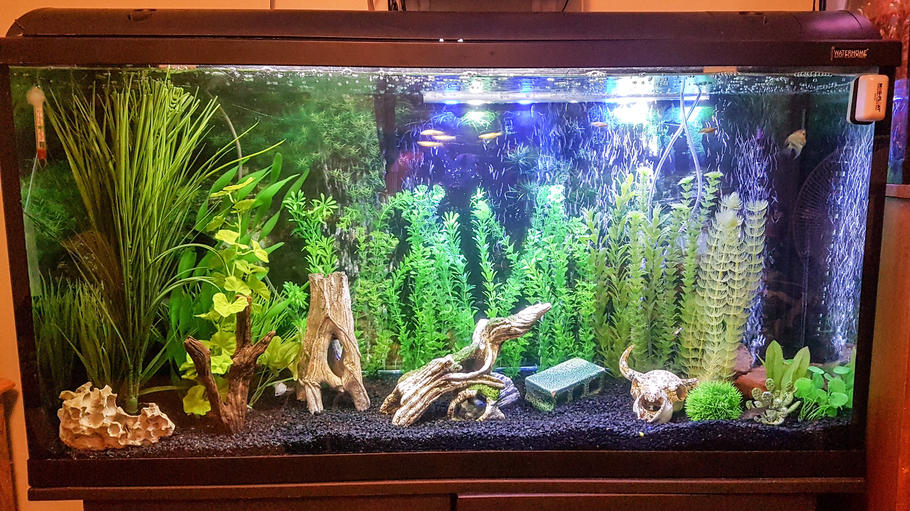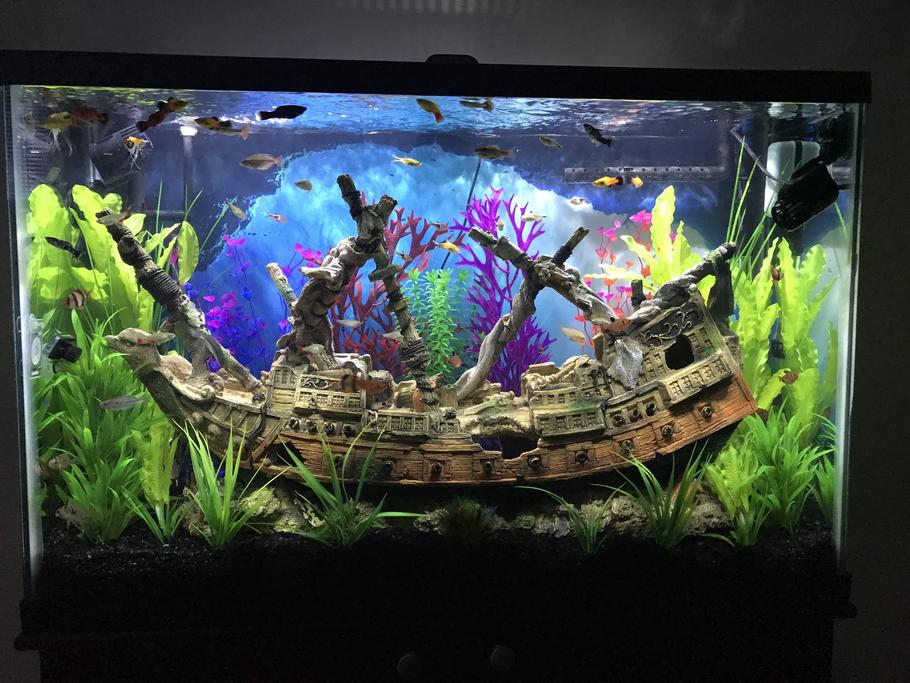CREATIVE HACKS TO KEEP YOUR AQUARIUM CLEAN

Updated
Keeping your aquarium clean doesn't have to be a chore with these simple aquarium cleaning "hacks".
Setting up and decorating a new aquarium can be a lot of fun. Once you’ve done the work, however, it falls on you to keep the tank running. After all, you don’t want all of your hard work to go to waste when, a few weeks or months down the line, all of your tank surfaces are covered in algae and grime.
Keeping your aquarium clean is not just a matter of aesthetics – it also has an impact on the health and wellbeing of your aquarium fish. Remember that an aquarium is a self-enclosed ecosystem, so any problems that arise have the potential to progress and worsen over time if you don’t handle them right away. That’s where these cleaning hacks come into play.
Cleaning your aquarium doesn’t have to be a huge job – with some clever “hacks” you can keep your tank in tip-top shape in no time at all.
Try These 10 “Hacks” To Clean Your Tank
While keeping your aquarium clean is important, you want to avoid doing any large-scale cleaning. You must remember that in addition to housing your fish, your tank also houses a colony of beneficial bacteria – bacteria that support the nitrogen cycle which helps to convert harmful byproducts of waste breakdown into less harmful substances that can be removed via water changes.
So, where do you draw the line between cleaning your tank too much and not cleaning it enough?
Here are some creative hacks you can use on a weekly or monthly basis to keep your aquarium clean, so you don’t have to risk a large-scale clean-out:
1. Use an aquarium water test kit once a week to check your tank parameters. After testing, record the results in a notebook and then compare the results from one week to the next. If you notice any significant discrepancies, it’s a sure sign that there’s a problem – take steps to address it now before it gets out of hand.
2. Perform a 10% to 25% water change every two weeks. Some aquarium hobbyists perform small weekly water changes with a larger water change once a month. You can save yourself some time and hassle by performing moderate water changes every two weeks.

3. Use a gravel vacuum when performing water changes. One of the main goals of performing a water change is to remove accumulated toxins and wastes from your tank. Solid waste products tend to accumulate on and in your tank substrate, so use a gravel vacuum when performing water changes so you can remove that accumulated debris.
4. Save time with a DIY water exchange system. If you have a very large aquarium, you’ll be siphoning out and replacing gallons and gallons of water every two weeks. To make the job easier, consider building a DIY water exchange system using PVC pipes. You can find instructions online for how to build one and then you can customize it for your unique tank setup.
5. Make your own magnetic algae scrubber to clean your tank walls. You can purchase algae scrub pads online or from your local pet store, then attach it to a strong magnet using fish-safe glue. Then, simply place the scrubber inside the tank and use another magnet to drag it around.
6. Consider planting some hornwort in your tank. Having live plants in your tank is a simple way to boost the oxygen levels in your tank water which improves conditions for your fish. Hornwort is a great plant to use because, not only does it produce oxygen, but it also absorbs nitrogen from your tank water so it can’t harm your fish.
7. Soak dirty tank decorations in a weak bleach solution. Over time, your tank decorations will accumulate at least a little bit of algae and scale. Rather than spending an hour scrubbing things by hand, soak them in a 10% bleach solution for 15 minutes before scrubbing. Just make sure you rinse everything thoroughly before putting it back.

8. Replace carbon filter media every 3 to 4 weeks. The carbon media in your filter is what helps remove dissolved toxins from your tank water. After a few weeks, the carbon’s ability to absorb toxins becomes exhausted so, unless you replace it, it won’t be doing you any good. If you want some extra toxin-absorbing power, take extra carbon filter inserts and place them in a mesh pouch or cut-off pantyhose and hang it somewhere in your tank. Rinse it weekly and replace it as often as you replace your filter media.
9. Use aquarium-safe lime cleaner to clean aquarium glass and fixtures. In addition to cleaning the inside walls of your aquarium, you should also clean the outer glass to remove water spots and fingerprints. An aquarium-safe lime cleaner will do the trick quite nicely and you can also use it to clean your aquarium fixtures. Just make sure it is aquarium-safe and rinse everything very well before putting it back.
10. Soak your fish nets in a disinfecting solution. Many aquarium hobbyists neglect their nets as part of regular aquarium cleaning and maintenance. If you don’t keep your nets clean, however, they can become stiff and might transfer bacteria and other pathogens to your tank water. Always soak your nets in a disinfectant solution after using them to keep them clean and soft.
These aquarium cleaning “hacks” only work if you actually use them and stay on top of your routine aquarium maintenance. It’s much better to perform quick cleanings more often than to spend an entire day on a full-scale cleaning of your tank. Try to create a weekly or biweekly tank maintenance schedule so you know exactly what tasks you’ll be performing and when.

Tips for Keeping Your Tank Water Clean
Remember, keeping your tank water clean isn’t just about making sure that your aquarium looks its best – it’s also about providing a healthy environment for your fish. Routine water changes and weekly testing will help keep your tank water clean and clear, but there are some other simple things you should do as well. Here are a few suggestions:
- Avoid overfeeding your fish. Your fish can only eat so much before the excess food sinks to the bottom of the tank where it breaks down and produces toxic byproducts. A good rule of thumb to follow is only feeding your fish as much as they can consume in 2 minutes. For long-lasting food products like algae wafers, remove any uneaten portions from the tank after an hour.
- Add some live plants. Not only can live plants increase the oxygen levels in your aquarium, but they also compete with algae for nutrients which can help keep your tank water clean and clear. Just remember that aquarium plants require certain nutrients to thrive, so make sure those needs are being met or you might end up making your water quality worse with a tank full of rotting plants.
- Don’t overuse your tank lighting. The longer you leave your tank lighting on, the more potential there is for it to affect your tank temperature and water quality. Algae needs light to thrive so, unless you have live plants in your tank that need strong lighting, you might want to tone down your tank lighting a little. You might even want to put them on a timer, so they only stay on for 10 to 12 hours at a time.
- Be mindful of aquarium placement. The worst place to put your aquarium is near a window. The direct sunlight will increase algae growth and it can also cause fluctuations in tank temperature. Place your tank out of direct sunlight and away from heating and cooling vents.
- Build a cleanup crew. If routine water changes aren’t enough to maintain high water quality in your tank, think about adding some algae-eaters to your tank. Remember, not all algae-eaters are fish- you can also use shrimp or snails to help control nuisance algae.
Maintaining a clean and thriving aquarium is not an impossible task, but you do need to stay on top of things. By putting to work the tips and hacks you’ve received here, you should have no trouble keeping your tank in tip-top shape. Best of luck!
comments powered by Disqus





















